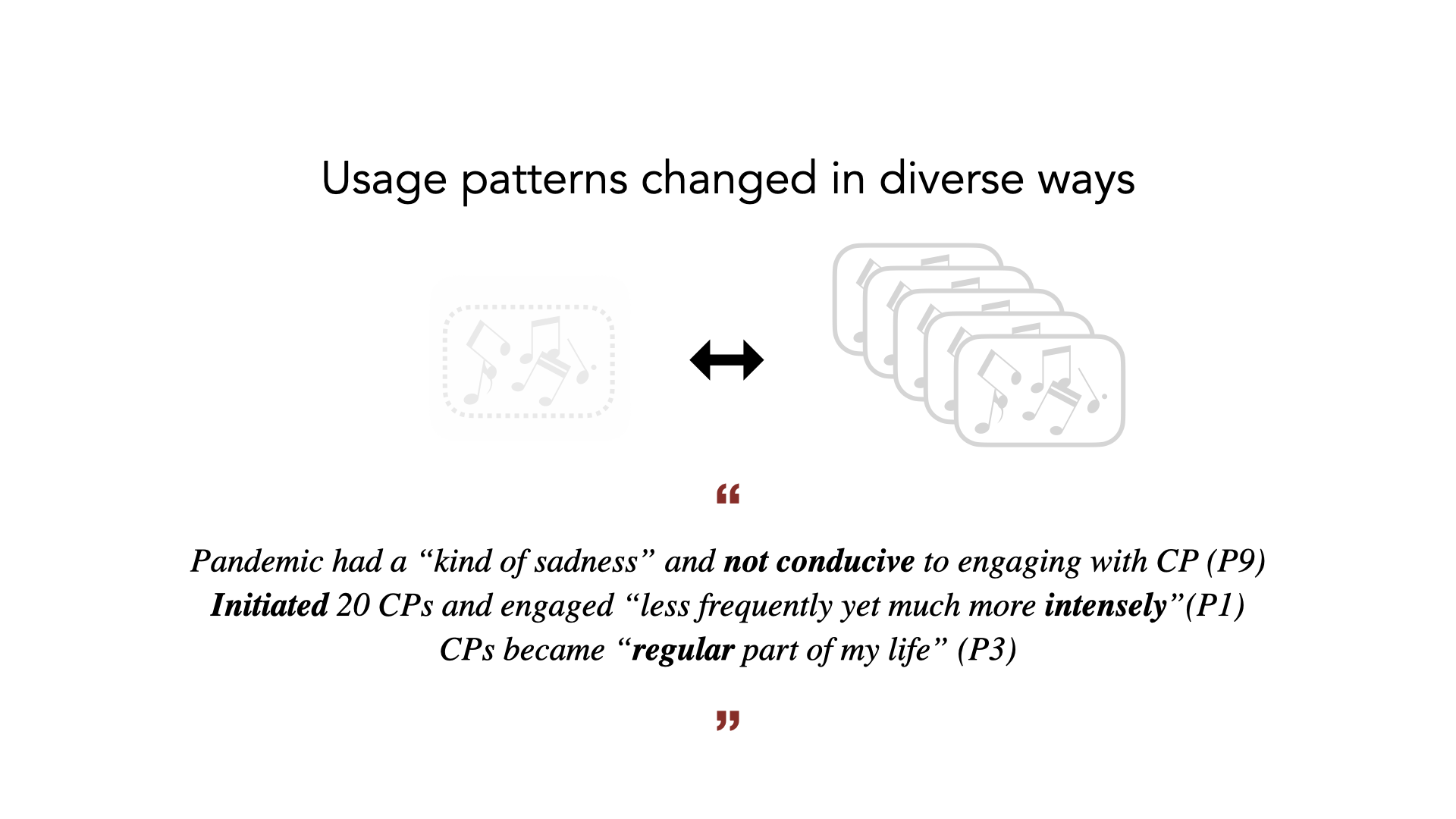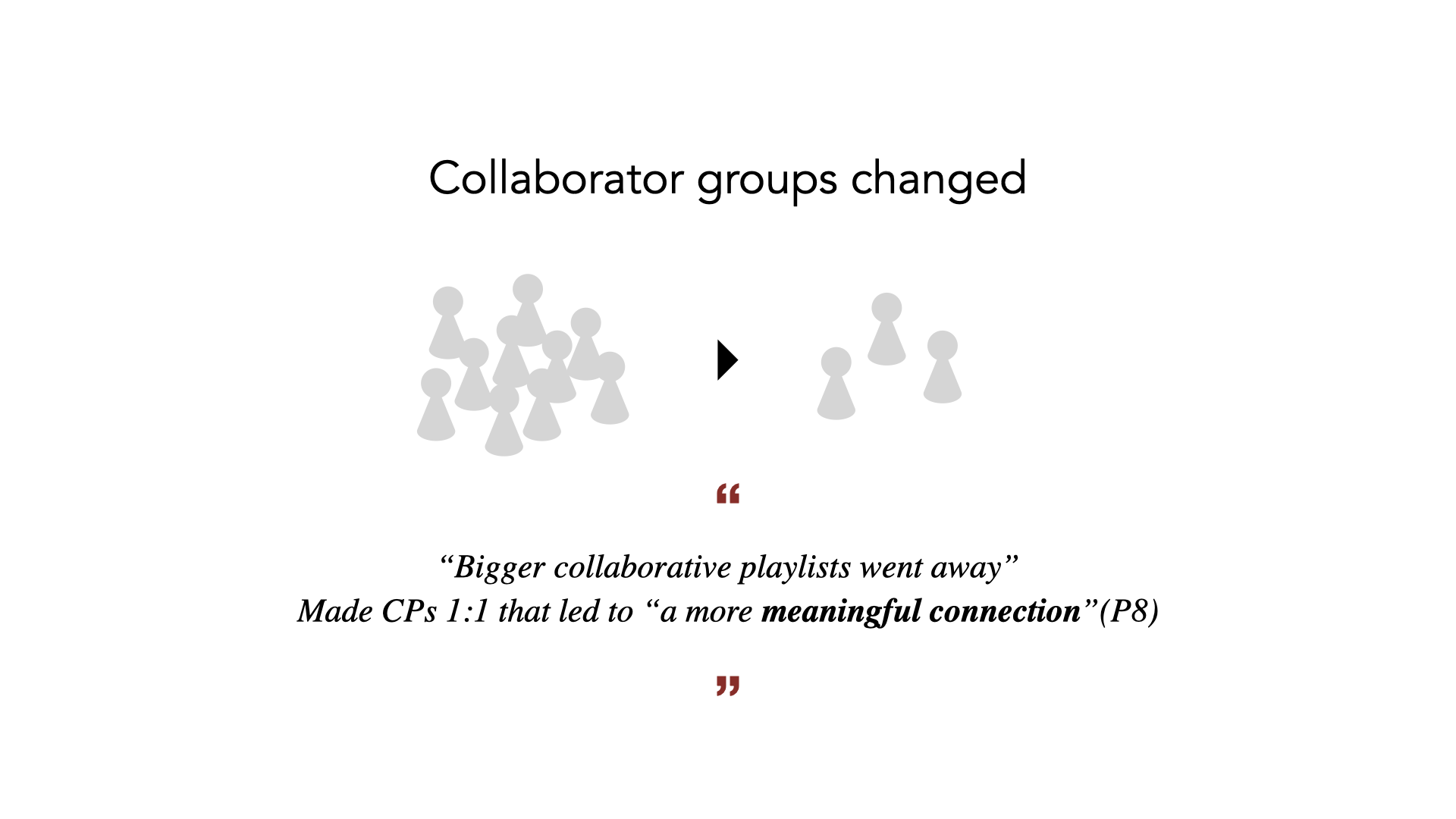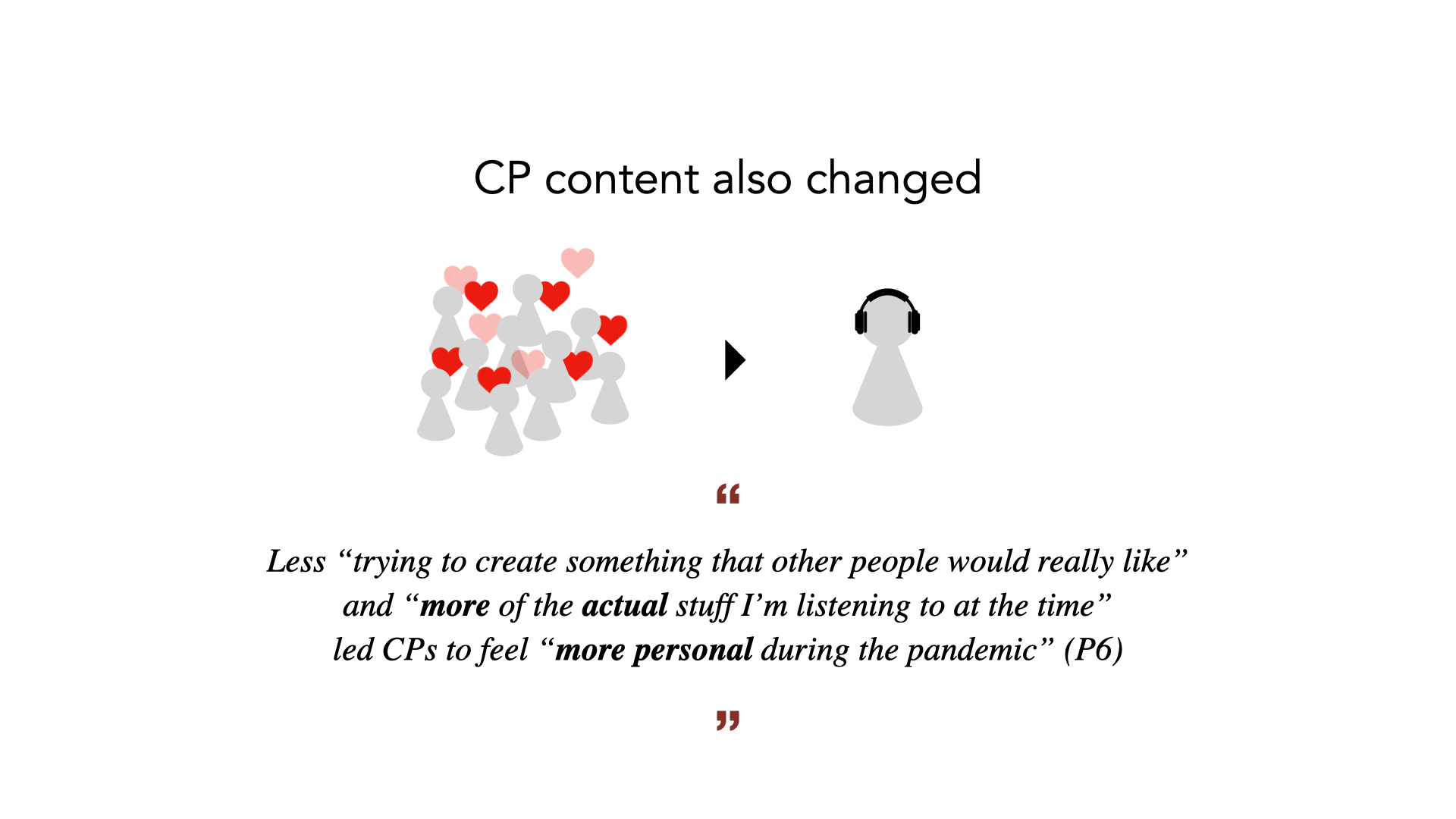Problem
Social features in music platforms are immensely important in keeping connections alive, especially during trying times like the COVID-19 pandemic.
Yet we do not know the extent of their importance, and music platforms often focus on other aspects to improve users’ experience (e.g., AI recommendations).
The Coronavirus Disease 2019 (COVID-19) has had a profound effect around the world. People relied on various computer-mediated interactions to cope with social isolation, anxiety, and loneliness. People also relied on music to manage pandemic-related social impacts. Collaborative playlists (CPs)—which have facilitated virtual music sharing, co-curation, and social connection even before COVID-19—may have become more important during the pandemic.
Research goals
To understand how the role of collaborative playlists have changed with the pandemic
To identify how music platforms can create a more meaningful experience for their users during trying times
Research questions
Survey study
RQ1: How has the COVID-19 pandemic influenced people’s perceptions of and engagement with CPs, as operationalized by interest and involvement, purpose for engaging, and outcomes?
RQ2: How has one’s perceived impact of the COVID-19 pandemic affected outcomes of CP usage and perceptions of social connectedness?
Interview study
RQ3: How has the COVID-19 pandemic influenced people’s usage of CPs?
RQ4: How have the role and usage of CPs changed for people during the pandemic, and why?
Survey study: CP perceptions before vs during pandemic
Method
We benchmarked an earlier survey (2019) [2] aimed at understanding perceptions around CPs and designed it with 4 parts:
Introduction to the terms “collaborative playlist” and “the pandemic” to ensure consistency of understanding
General CP questions
Non-users: Interest in, probable collaborators of, probable purposes for, and expected outcomes of CP engagement
Users: Purposes for, length of, and expected outcomes of CP engagement; change in interest and involvement in CPs due to the pandemic
General music habits: Social connection through music, change in music-related engagement due the pandemic, change in importance of certain kinds of music
Demographics questions
A total of N = 142 full responses from both CP users and non-users were collected form recruitment through listservs, social media, and word of mouth.
Why this method—i.e., survey?
To make direct comparisons of user perceptions around CPs between before and during the pandemic
Core survey results
Influence of the COVID-19 pandemic on CP perceptions and engagement (RQ1)
Barchart of how much users perceived their interest and involvement in CPs have changed due to the pandemic.
CP interest and involvement have increased overall
📊 Analysis: Distribution (Descriptive statistics)
We found that the majority of CP users felt both their interest and involvement in CPs increased due to the pandemic for the most part (80% and 78% respectively).
Some outcomes of CP engagement increased during COVID-19
📊 Analysis: Distribution (Descriptive statistics), Wilcoxon Rank Sum test
Quantitative comparisons of pre- and during-pandemic user responses using Wilcoxon Rank Sum tests revealed statistically significant differences in outcomes with respect to 5 statements—for all of these statements, agreement was higher in the present sample:
“required less of my effort to enjoy music” (𝑊 = 5968.5, pFDR < 0.05)
“made listening to music more enjoyable” (𝑊 = 6055.5, pFDR < 0.001)
“changed the music that I listen to” (𝑊 = 5678.5, pFDR < 0.05)
“made me appreciate music platforms with CPs more” (𝑊 = 5711, pFDR < 0.05)
“made me more open to new experiences in general” (𝑊 = 6626, pFDR < 0.001)
Barplots show how agreement to “Collaborative playlist(s) could/have...” statements have increased among participants during the pandemic compared to those before the pandemic. Medians are shown by thick lines and the dots represent outliers.
Boxplots of (A) projected and actual outcomes of CP usage (i.e., agreement with the statements “Collaborative playlist(s) could/have...” followed by Q2a–Q2j) by how much participants perceived to be affected by the pandemic (Q2) and (B) perceived role of music in connecting with others (i.e., agreement with the statements presented) by how much participants reported being affected by the pandemic. Grouping (as indicated by the colors) depends on the extent to which in-person activities have been affected by the COVID-19 pandemic. Medians are shown by thick lines and the dots represent outliers.
Effects of perceived impact of COVID-19 on CP perceptions and engagement (RQ2)
📊 Analysis: Kruskal-Wallis test
Change in interest and involvement in CPs did not vary significantly according to perceived impact of the pandemic, but we found a marginally significant difference in agreement across impact groups for “positively influenced my music taste” (pFDR < 0.1).
We also investigated whether the level of agreement to statements relating to connection through music varied according to the extent to which a participant felt affected by the pandemic. Kruskal-Wallis tests indicated that participants’ agreement to statements that “music has helped to connect with others”—both “personally” (H(3) = 22.32, pFDR < 0.001) and “in general” (H(3) = 10.77, pFDR < 0.05)—varied significantly according to how much they reported being impacted by the pandemic.
Interview study: Pandemic’s influence on CP usage & perception
Method
We conducted semi-structured interviews with N = 9 participants (8 CP users and 1 non-user) as a follow-up to the survey study to glean more nuanced user perceptions and experiences around CPs. The interviews were conducted via Zoom (each 35 – 50 minutes) and were centered around the follow core questions:
Have your feelings around CPs changed with the pandemic, and if so, how?
Did your usage pattern of CPs change with the pandemic, and if so, how?
What role did the CP serve for you and your friends during the pandemic?
Can you say a little more about the role of music as a whole in your life compared to the feeling of engaging in CPs specifically?
*Only survey respondents were eligible to participate in follow-up interviews.
Why this method—i.e., semi-structured interviews?
Because it is “well suited for the exploration of the perceptions and opinions of respondents [...] and enable probing for more information and clarification of answers” [3]
Core interview results
Influence of COVID-19 pandemic on usage of CPs (RQ3)
📊 Analysis: Thematic analysis
Themes regarding how CP usage and engagement from interviewee responses emerged as follows.




Influence of COVID-19 pandemic on the role of CPs and music (RQ4)
📊 Analysis: Thematic analysis
Overall, CPs played a critical role in facilitating people’s connections with others during the time of the pandemic.
During, and due to, the pandemic, people’s perceptions of CPs changed greatly, from entertaining towards “reconnecting” as described by P6, who said CPs before the pandemic was “not really about reconnecting” but rather “having fun and sharing music together, and it wasn’t anything super deep”. Now, P6 saw CPs as a “way to share how we’re feeling and what we were experiencing at the time when we couldn’t really talk to each other especially during the pandemic and also was a way to do nice things for each other”.
Many other interviewees echoed this sentiment.
Impact
✨ Highlighted the importance of social features in music platforms
We have highlighted what users consider as important part of their music platform experience (i.e., social aspect), which has only heightened with the COVID-19 pandemic. In doing so, we are challenging the recent focus of music platforms on automated recommendations and curations. To enable users to have meaningful experiences around music, which is already inherently social, music platforms ought to bring humans into their platforms, rather than trying to replace them.
✨ Demonstrated causality
We showed that there was a causal relationship between collaborative playlist engagement with social connection through our investigation, while the previous work showed correlation.
✨ Derived design implications for bringing more meaningful user experiences on music platforms
Inclusion of more social functionalities can amplify CP’s role in connecting with others
CP designs should support new users seeking connection during socially distant times
CP platforms should enable users to include more of their personal touches
Platform designs should support the broader role of music during COVID-19
Reflections
🤔 Within-subject comparisons of participants before vs during pandemic
Although not possible as we were not collecting PII for the survey responses, had we been able to recruit the same participants who participated in the initial CP study (in 2019), we would be able to compare directly participants’ perceptions and behavior before and during the pandemic.
🤔 Direct observations and contextual inquiry of collaborative playlists usage during pandemic
Conducting more contextualized investigation would have enabled us to observe and quantify the change in CP usage more clearly and more quantifiably between participants.
🤔 Comparison between social vs non-social features
While this was not within the scope of our research, comparing user perceptions (e.g., satisfaction, usage, importance) of social features against non-social features would enable researchers to make a solid claim regarding which features to put more efforts into in order to improve user experience.
Results & Analyses +
In case you wanted to see more :)
Purposes for CP usage largely reflect existing CP Framework categories
📊 Analysis: Distribution (Descriptive statistics), Chi-square test
We found that the same purposes and connotations for engaging in CPs were mentioned in our sample. However, when comparing the extent to which CP Framework categories were mentioned in the present sample relative to the pre-pandemic sample we found that Practical and Social purposes have become less prevalent while Cognitive purposes remained more similar to the pre-pandemic sample. Mentions of Utility also remained similar while Orientation mentions dropped.
Chi-square tests conducted on 2×2 sample-by-membership contingency tables for each CP Framework category confirmed each of these observations: CP Framework category mentions varied significantly by sample for Practical (𝜒2 = 6.33, pFDR < 0.05), Social (𝜒2 = 6.75, pFDR < 0.05), and Orientation (𝜒2 = 4.83, pFDR < 0.05) but not for Cognitive or Utility (𝜒2 ≤ 0.39, pFDR > 0.1).
The CP Framework, which encapsulates purposes that emerged from free-text responses across users and non-users (from 2019 study).
Barchart of CP purposes mentioned in free-text responses from survey respondents before (2019) and during (2021) the pandemic.
Perceived social connection through music declined during COVID-19
📊 Analysis: Distribution (Descriptive statistics), Wilcoxon Rank Sum test
Comparing current survey CP users’ perceptions of music’s role in social connectedness during the pandemic to corresponding questions prior to the pandemic (i.e., “over the past 5 years”) using Wilcoxon Rank Sum tests indicated that the two statements of “connecting with others through music has declined” differed significantly between samples, both in general and personally (𝑊 ≥ 6269, pFDR < 0.001); in both cases the present sample agreed more with these statements. For statements that “music has helped people connect with others”, only general perceptions differed significantly across samples (𝑊 = 3932, pFDR < 0.05), with higher agreement pre-pandemic; perceptions that music personally helped connect did not differ significantly (𝑊 = 4271, pFDR > 0.1).
Music relieves pressure and fulfills other roles during COVID-19
📊 Analysis: Thematic analysis
Thematic analysis of free-text reports on the more general role of music during the pandemic led to 6 categories that characterized all the responses.
Of these, the most-reported role of music during COVID-19 was one of “relieving pressure” (43% of responses), helping people to “calm” down, “soothe”, and “relax”.
Music was also a “friend” to many (32%), as it provided “entertainment” and a way to “pass the time”.
Related to relieving pressure, music helped participants “keep sanity”, “escape” from reality, and “distract” themselves (18%).
Facilitating connection was implicated often (17%). Here we found that music served as a way to “connect” and “communicate” with others (e.g., “discussions”), as well as “bringing people together” leading to a sense of “community”.
Furthermore, music uplifted participants (15%), enabling them to feel “happy”, “motivated”, and “productive”.
Finally, music was a channel for “nostalgia” (4%), “reminding [participants] of when times were easier” and “bring[ing them] back to pre-pandemic memories”.
Related publications
Select references
[1] Krastel, Z., Bassellier, G., & Ramaprasad, J. (2015). Music is social: From online social features to online social connectedness.
[2] Park, S. Y., Laplante, A., Lee, J. H., & Kaneshiro, B. (2019). Tunes Together: Perception and Experience of Collaborative Playlists. In ISMIR (pp. 723-730).
[3] Barriball, K. L., & While, A. (1994). Collecting data using a semi-structured interview: a discussion paper. Journal of Advanced Nursing-Institutional Subscription, 19(2), 328-335.









